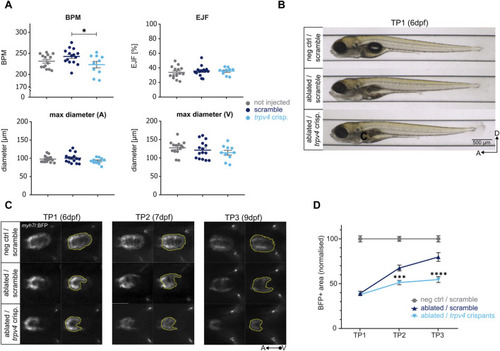
Determining the effect of genes on regeneration kinetics. The CRISPR/Cas9-driven loss of function of trpv4 leads to an impaired regeneration. (A) The loss of function of trpv4 does not lead to an overt cardiac development defect compared to non-injected and scramble-injected controls at 5dpf as seen in the following functional and morphological ZeCardio readouts: beats per minute (BPM), ejection fraction (EJF), and maximum diameter of the atrium (A) and ventricle (V). A significant reduction in BPM is observed compared to scramble control (p = 0.0456) but not non-injected control (p = 0.5635). N = 14, 15, 10 for not injected control, scramble control, and trpv4 crispants, respectively. (B) The loss of function of trpv4 does not lead to any overt developmental defects compared to scramble-injected ablated larvae at 6dpf (TP1). (C) Representative images of ventral view of ventricles during systole (left) and BFP + ventricular areas (right) at TP1, TP2, and TP3. The loss of function of trpv4 leads to a decrease in BFP+ ventricular area compared to scramble-injected ablated control at both TP2 and TP3. (D) Regeneration kinetics graph. The loss of function of trpv4 leads to a highly significant decrement in BFP+ area at both TP2 and TP3 compared to scramble-injected ablated control. Two separate experiments were performed, and values pooled after normalisation to corresponding negative control at each time point. TP1: N = 24, 27, 35; TP2: N = 16, 20, 31; TP3: N = 8, 18, 27 for negative scramble-injected control, ablated scramble-injected control, and ablated trpv4 crispants, respectively. At TP2, p = 0.0002; at TP3, p <0.0001.
|

